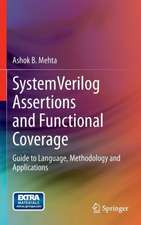Direct Digital Synthesizers: Theory, Design and Applications: The Springer International Series in Engineering and Computer Science, cartea 614
Autor Jouko Vankka, Kari A.I. Halonenen Limba Engleză Paperback – 7 dec 2010
It is easy to include different modulation capabilities in the DDS by using digital signal processing (DSP) methods, because the signal is in digital form. By programming the DDS, adaptive channel bandwidths, modulation formats, frequency hopping and data rates are easily achieved. The flexibility of the DDS makes it ideal for signal generator for software radio. The digital circuits used to implement signal-processing functions do not suffer the effects of thermal drift, aging and component variations associated with their analog counterparts. The implementation of digital functional blocks makes it possible to achieve a high degree of system integration. Recent advances in IC fabrication technology, particularly CMOS, coupled with advanced DSP algorithms and architectures are providing possible single-chip DDS solutions to complex communication and signal processing subsystems as modulators, demodulators, local oscillators, programmable clock generators, and chirp generators. The DDS addresses a variety of applications, including cable modems, measurement equipments, arbitrary waveform generators, cellular base stations and wireless local loop base stations.
Direct Digital Synthesizers was written to find possible applications for radio communication systems. It will have appeal for wireless and wireline communication engineers, teachers and students.
| Toate formatele și edițiile | Preț | Express |
|---|---|---|
| Paperback (1) | 940.72 lei 6-8 săpt. | |
| Springer Us – 7 dec 2010 | 940.72 lei 6-8 săpt. | |
| Hardback (1) | 946.24 lei 6-8 săpt. | |
| Springer Us – 31 mai 2001 | 946.24 lei 6-8 săpt. |
Din seria The Springer International Series in Engineering and Computer Science
- 24%
 Preț: 1041.98 lei
Preț: 1041.98 lei - 20%
 Preț: 643.50 lei
Preț: 643.50 lei - 18%
 Preț: 1225.62 lei
Preț: 1225.62 lei - 18%
 Preț: 965.02 lei
Preț: 965.02 lei - 20%
 Preț: 646.12 lei
Preț: 646.12 lei - 18%
 Preț: 948.79 lei
Preț: 948.79 lei - 20%
 Preț: 646.62 lei
Preț: 646.62 lei - 15%
 Preț: 637.46 lei
Preț: 637.46 lei - 20%
 Preț: 643.83 lei
Preț: 643.83 lei - 18%
 Preț: 949.23 lei
Preț: 949.23 lei - 20%
 Preț: 644.48 lei
Preț: 644.48 lei - 20%
 Preț: 994.92 lei
Preț: 994.92 lei - 20%
 Preț: 645.97 lei
Preț: 645.97 lei - 18%
 Preț: 946.87 lei
Preț: 946.87 lei - 20%
 Preț: 995.57 lei
Preț: 995.57 lei - 18%
 Preț: 956.99 lei
Preț: 956.99 lei - 20%
 Preț: 644.98 lei
Preț: 644.98 lei - 15%
 Preț: 649.54 lei
Preț: 649.54 lei - 18%
 Preț: 950.21 lei
Preț: 950.21 lei - 18%
 Preț: 1221.38 lei
Preț: 1221.38 lei - 18%
 Preț: 957.62 lei
Preț: 957.62 lei - 15%
 Preț: 643.99 lei
Preț: 643.99 lei - 18%
 Preț: 948.47 lei
Preț: 948.47 lei - 18%
 Preț: 947.35 lei
Preț: 947.35 lei - 20%
 Preț: 1284.65 lei
Preț: 1284.65 lei - 20%
 Preț: 1628.31 lei
Preț: 1628.31 lei - 20%
 Preț: 1285.78 lei
Preț: 1285.78 lei
Preț: 940.72 lei
Preț vechi: 1147.21 lei
-18% Nou
Puncte Express: 1411
Preț estimativ în valută:
179.100€ • 187.95$ • 148.64£
179.100€ • 187.95$ • 148.64£
Carte tipărită la comandă
Livrare economică 15-29 aprilie
Preluare comenzi: 021 569.72.76
Specificații
ISBN-13: 9781441948953
ISBN-10: 1441948953
Pagini: 216
Ilustrații: XXI, 193 p.
Dimensiuni: 155 x 235 x 11 mm
Greutate: 0.31 kg
Ediția:Softcover reprint of hardcover 1st ed. 2001
Editura: Springer Us
Colecția Springer
Seria The Springer International Series in Engineering and Computer Science
Locul publicării:New York, NY, United States
ISBN-10: 1441948953
Pagini: 216
Ilustrații: XXI, 193 p.
Dimensiuni: 155 x 235 x 11 mm
Greutate: 0.31 kg
Ediția:Softcover reprint of hardcover 1st ed. 2001
Editura: Springer Us
Colecția Springer
Seria The Springer International Series in Engineering and Computer Science
Locul publicării:New York, NY, United States
Public țintă
ResearchCuprins
1. Introduction.- 2. Direct Digital Synthesizer.- 3. Indirect Digital Synthesizer.- 4. CORDIC Algorithm.- 5. Sources of Noise and Spurs in DDS.- 6. Blocks of Direct Digital Synthesizer.- 7. Spur Reduction Techniques in Sine Output Direct Digital Synthesizer.- 8. Up-Conversion.- 9. Direct Digital Synthesizer with an On-Chip D/A-Converter.- 10. CMOS Quadrature IF Frequency Synthesizer/Modulator.- 11. Multi-Carrier QAM Modulator.- 12. Single Carrier QAM Modulator.- 13. Multi-Carrier GMSK Modulator.- 14. Conclusions.- References.- Appendix A: Fourier Transform of DDS Output.- Appendix B: Derivation Output Current of Bipolar Current Switch with Base Current Compensation.- Appendix C: Digital Phase Pre-distortion of Quadrature Modulator Phase Errors.- Appendix D: Different Recently Reported DDS ICs.





















